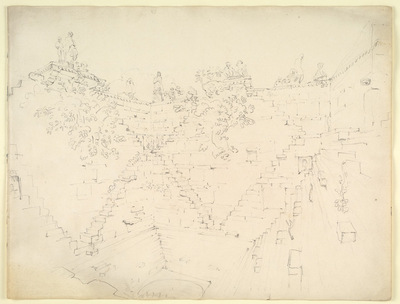Javascript must be enabled to continue!
Step well, Benares
View through Europeana Collections
Pencil drawing by James Prinsep (1799-1840), of a
step well at Varanasi (Benares)in Uttar Pradesh. The image is
inscribed on the reverse: 'Section of the Ganges opposite the
Minarets at low water mark 25 April 1829', together with notes and
measurements. Step wells were a solution to the dry conditions in a
number of Indian states; catching monsoon water and storing it in
deep wells to keep it cool. They became a specialised architectural
form, especially in Gujarat, where they were often very deep with
numerous storeys and elaborate carvings. The one pictured here is
of much simpler construction, consisting of an open well with a
number of diagonal sets of steps leading down to it.James Prinsep,
a noted scholar, antiquarian and Assay Master at the Benares and
Calcutta Mints, came from a family who served in India for several
generations. Varanasi stands on the left bank of the Ganges and at
its highest point stood well away from the river, but as the ground
receded towards the water stagnant pools and marshes formed near
the most densely inhabited areas during the rainy season and became
a danger to health. Prinsep devised a plan to drain the city and
built a network of drains and a tunnel which were considered a
great feat of engineering. The sewer was opened in 1824 and the
tunnel, in 1827.
Title: Step well, Benares
Description:
Pencil drawing by James Prinsep (1799-1840), of a
step well at Varanasi (Benares)in Uttar Pradesh.
The image is
inscribed on the reverse: 'Section of the Ganges opposite the
Minarets at low water mark 25 April 1829', together with notes and
measurements.
Step wells were a solution to the dry conditions in a
number of Indian states; catching monsoon water and storing it in
deep wells to keep it cool.
They became a specialised architectural
form, especially in Gujarat, where they were often very deep with
numerous storeys and elaborate carvings.
The one pictured here is
of much simpler construction, consisting of an open well with a
number of diagonal sets of steps leading down to it.
James Prinsep,
a noted scholar, antiquarian and Assay Master at the Benares and
Calcutta Mints, came from a family who served in India for several
generations.
Varanasi stands on the left bank of the Ganges and at
its highest point stood well away from the river, but as the ground
receded towards the water stagnant pools and marshes formed near
the most densely inhabited areas during the rainy season and became
a danger to health.
Prinsep devised a plan to drain the city and
built a network of drains and a tunnel which were considered a
great feat of engineering.
The sewer was opened in 1824 and the
tunnel, in 1827.
Related Results
figur, skulptur, staty, statue, sculpture
figur, skulptur, staty, statue, sculpture
1887.08.5172+5173. Function: For as long as we have known, people have come to Benares to be able to meet the gods, primarily Shiva, but also to die, be cremated and be released f...
skulptur, staty, figur, sculpture, statue
skulptur, staty, figur, sculpture, statue
1887.08.5172+5173. Function: For as long as we have known, people have come to Benares to be able to meet the gods, primarily Shiva, but also to die, be cremated and be released f...
Sketch map of the Barna river from Garstin's bridge to the
Old Fort, Benares
Sketch map of the Barna river from Garstin's bridge to the
Old Fort, Benares
Pen and ink and wash sketch map of the Barna
river from Garstin's bridge to the Old Fort at Varanasi (Benares)
in Uttar Pradesh, by James Prinsep (1799-1840), dated 1824. The
image...
Building work on the drainage tunnel from the Machhodri tank
to the river
Building work on the drainage tunnel from the Machhodri tank
to the river
Watercolour by James Prinsep (1799-1840), of
building work on the drainage tunnel from the Machhodri tank to the
river at Varanasi (Benares) in Uttar Pradesh, dated 1826. The image...
[Croquis of the ground floor of the Alcázar of Seville] [Material graphic]
[Croquis of the ground floor of the Alcázar of Seville] [Material graphic]
Handwritten annotation with pen and brown ink on the upper left side: "Explanation/1 Gate of the monteria p.a enter the Palace/2 Employee rooms/3 Cocheras/4 Material storage/5 Step...
View of the Brahmaputra and Himalaya mountains from
Dibrugarh (Assam)
View of the Brahmaputra and Himalaya mountains from
Dibrugarh (Assam)
Watercolour by Edward Augustus Prinsep
(1828-1900), of the Brahmaputra and Himalaya mountains from
Dibrugarh in Assam, dated c.1848. The image is inscribed on the
front in ink: 'Th...




